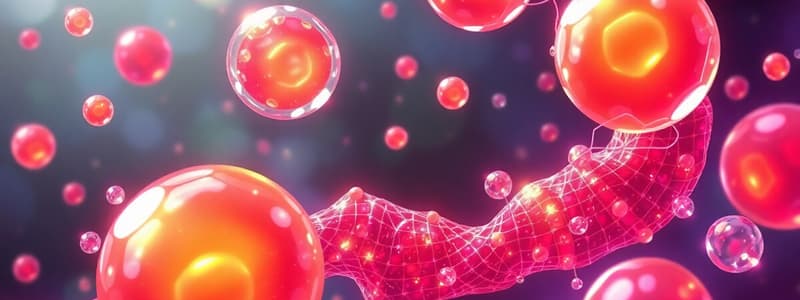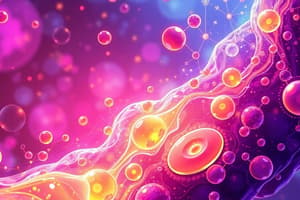Podcast
Questions and Answers
Which statement correctly describes saturated fatty acids?
Which statement correctly describes saturated fatty acids?
- They are water-soluble compounds.
- They are always comprised of an odd number of carbon atoms.
- They contain only single bonds along the length of the carbon chain. (correct)
- They contain one or more double bonds in the hydrocarbon chain.
What is the energy value provided by 1 gram of lipids?
What is the energy value provided by 1 gram of lipids?
- 11 kcal
- 7 kcal
- 9 kcal (correct)
- 4 kcal
How are unsaturated fatty acids classified?
How are unsaturated fatty acids classified?
- By the presence of a hydroxyl group.
- By the number of double bonds present per fatty acid. (correct)
- By their solubility in water.
- By the number of carbons they contain.
Which of the following is an essential fatty acid?
Which of the following is an essential fatty acid?
In the numbering of carbon atoms in fatty acids, which carbon is known as the α-carbon?
In the numbering of carbon atoms in fatty acids, which carbon is known as the α-carbon?
What is indicated by the symbol Δ in fatty acids?
What is indicated by the symbol Δ in fatty acids?
When numbering fatty acid carbons from the omega end, what does ω9 indicate?
When numbering fatty acid carbons from the omega end, what does ω9 indicate?
Which of the following fatty acids is typically saturated?
Which of the following fatty acids is typically saturated?
Which lipid is primarily a component of the cell membrane and contributes to its rigidity?
Which lipid is primarily a component of the cell membrane and contributes to its rigidity?
Which of the following are classes of eicosanoids derived from arachidonic acid?
Which of the following are classes of eicosanoids derived from arachidonic acid?
What is the process called when triglycerides undergo hydrolysis with KOH or NaOH?
What is the process called when triglycerides undergo hydrolysis with KOH or NaOH?
Which of the following fatty acids is essential for the human body?
Which of the following fatty acids is essential for the human body?
What type of lipid predominantly serves as a precursor for sex hormones and bile salts?
What type of lipid predominantly serves as a precursor for sex hormones and bile salts?
Which of the following statements about rancidity is true?
Which of the following statements about rancidity is true?
The basic structure of cell membranes is primarily composed of which arrangement?
The basic structure of cell membranes is primarily composed of which arrangement?
What is the common name for the monoenoic acid with 18 carbon atoms and one double bond?
What is the common name for the monoenoic acid with 18 carbon atoms and one double bond?
Which fatty acid is classified as ω3 and has six double bonds?
Which fatty acid is classified as ω3 and has six double bonds?
Which fatty acid is essential and categorized as ω6 with two double bonds?
Which fatty acid is essential and categorized as ω6 with two double bonds?
In the classification of lipids, what distinguishes complex lipids from simple lipids?
In the classification of lipids, what distinguishes complex lipids from simple lipids?
Which of the following is NOT a characteristic of monoenoic fatty acids?
Which of the following is NOT a characteristic of monoenoic fatty acids?
Which fatty acid has 20 carbon atoms and is a key component of phospholipids in animals?
Which fatty acid has 20 carbon atoms and is a key component of phospholipids in animals?
What is the classification of fatty acids that have three double bonds?
What is the classification of fatty acids that have three double bonds?
Which family does the fatty acid γ-Linolenic belong to?
Which family does the fatty acid γ-Linolenic belong to?
Flashcards
Monoenoic acids
Monoenoic acids
Fatty acids with one double bond.
Dienoic acids
Dienoic acids
Fatty acids with two double bonds.
Trienoic acids
Trienoic acids
Fatty acids with three double bonds.
Tetraenoic acids
Tetraenoic acids
Signup and view all the flashcards
Pentaenoic acids
Pentaenoic acids
Signup and view all the flashcards
Hexaenoic acids
Hexaenoic acids
Signup and view all the flashcards
Fats
Fats
Signup and view all the flashcards
Waxes
Waxes
Signup and view all the flashcards
What are lipids?
What are lipids?
Signup and view all the flashcards
What are fatty acids?
What are fatty acids?
Signup and view all the flashcards
Describe saturated fatty acids.
Describe saturated fatty acids.
Signup and view all the flashcards
Describe unsaturated fatty acids.
Describe unsaturated fatty acids.
Signup and view all the flashcards
What are monounsaturated fatty acids?
What are monounsaturated fatty acids?
Signup and view all the flashcards
What are polyunsaturated fatty acids?
What are polyunsaturated fatty acids?
Signup and view all the flashcards
How are carbon atoms in FAs numbered?
How are carbon atoms in FAs numbered?
Signup and view all the flashcards
What is the omega (ω) carbon?
What is the omega (ω) carbon?
Signup and view all the flashcards
Glycolipids
Glycolipids
Signup and view all the flashcards
Glucocerebrosides
Glucocerebrosides
Signup and view all the flashcards
Galactocerebrosides
Galactocerebrosides
Signup and view all the flashcards
Gangliosides
Gangliosides
Signup and view all the flashcards
Lipoproteins
Lipoproteins
Signup and view all the flashcards
Steroids
Steroids
Signup and view all the flashcards
Cholesterol
Cholesterol
Signup and view all the flashcards
Eicosanoids
Eicosanoids
Signup and view all the flashcards
Study Notes
Lipids
- Lipids are a group of compounds related to fatty acids.
- They are insoluble in water but soluble in fat solvents like ether and benzene.
- Lipids are essential dietary components, providing high energy value (1g = 9 kcal), fat-soluble vitamins, and essential fatty acids.
Fatty Acids
- Fatty acids are monocarboxylic acids with a long hydrocarbon chain.
- Two main types: saturated and unsaturated.
- Saturated fatty acids contain only single bonds in their carbon chain. Carbon atoms are fully saturated with hydrogen. Fatty acids in the human body contain an even number of carbon atoms (e.g., 4, 6, 8...).
- Unsaturated fatty acids contain one or more double bonds in the carbon chain. They are further classified as monounsaturated (one double bond) or polyunsaturated (two or more double bonds). Carbon atoms are numbered starting from the carboxyl carbon (carbon number 1). Carbon atoms adjacent to the carboxyl carbon are called α, β, γ. The terminal methyl carbon is the ω or n carbon. The site of unsaturation is indicated by the Δ symbol. Δ9 indicates a double bond between carbons 9 and 10.
Saturated Fatty Acids Examples
- Butyric acid (4 carbons)
- Lauric acid (12 carbons)
- Myristic acid (14 carbons)
- Palmitic acid (16 carbons)
- Stearic acid (18 carbons)
- Arachidic acid (20 carbons)
Unsaturated Fatty Acids of Significance
| Number of Carbon Atoms & Double Bonds | Family | Common Name |
|---|---|---|
| 16:1 | Monoenoic | Palmitoleic |
| 18:1 | Monoenoic | Oleic |
| 18:1 | Monoenoic | Elaidic |
| 18:2 | Dienoic | Linoleic |
| 18:3 | Trienoic | γ-Linolenic |
| 18:3 | Trienoic | α-Linolenic |
Unsaturated Fatty Acids of Significance (Continued)
| Number of Carbon Atoms & Double Bonds | Family | Common Name | Occurrence |
|---|---|---|---|
| 20:4 | Tetraenoic | Arachidonic | Found in animal fats, important component of phospholipids in animals |
| 20:5 | Pentaenoic | Timnodonic | Important component of fish oils |
| 22:6 | Hexaenoic | Cervonic | Fish oils, phospholipids in brain |
Classification of Lipids
- Simple Lipids: Neutral fats, Waxes
- Complex Lipids: Phospholipids, Glycolipids, Lipoproteins
- Derived Lipids: Fatty acids, Glycerol, Steroids, some alcohols, fatty aldehydes, ketone bodies.
Steroids
- Steroids are compounds containing the cyclopentanoperhydrophenanthrene ring.
- Common steroids include cholesterol, ergosterol, bile acids, sex hormones, adrenal cortical hormones, and vitamin D3.
- Cholesterol is a major sterol in the body, a constituent of cell membranes.
- Cholesterol is a precursor for other steroids.
Eicosanoids
- Eicosanoids are compounds derived from arachidonic acid.
- Subgroups: Prostanoids, Leukotrienes, Lipoxins.
- Prostanoids (e.g., prostaglandins) have significant physiological and pharmacological activities in the human body.
- Leukotrienes cause bronchoconstriction and play a role in asthma.
Chemical Properties of Lipids
- Saponification: Hydrolysis of TAG (triacylglycerols) with KOH or NaOH.
- Rancidity: Hydrolysis and oxidation of unsaturated fatty acids in fats, due to atmospheric moisture and temperature, producing hydrogen peroxide, giving a bad odor and taste to the fats. Antioxidant prevent rancidity.
Cell Membrane and Cell Membrane Lipids
- Cell Membranes are complex structures composed of lipids, proteins, and carbohydrates.
- The basic structure of cell membranes is a lipid bilayer. Phospholipids form the bilayer, with their polar hydrophilic heads facing the aqueous environments (inside and outside the cell) and their nonpolar hydrophobic tails facing inward.
- Phospholipids, Glycolipids and Cholesterol are important components of cell membranes, with Phospholipids containing choline being a notable example.
Studying That Suits You
Use AI to generate personalized quizzes and flashcards to suit your learning preferences.




